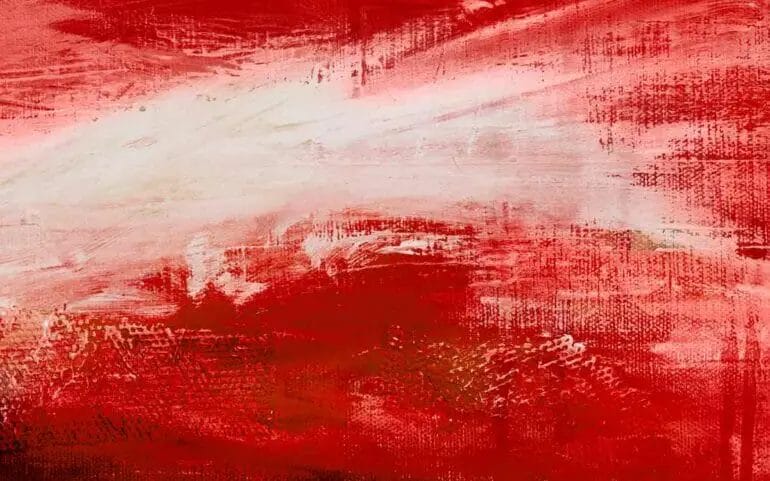When it comes to acrylic painting, there are a lot of different ways to do things. Some artists might prefer one method over another, but the beauty of acrylics is that there are so many options!
You can layer paint in different ways to create unique and interesting effects. Here are a few tips on how to layer acrylic paint effectively.

How to Give Your Painting Depth Through Layers in Acrylic Paint?
There are several different ways you can create depth in acrylic painting. These ways include shading and contrast, layering and overlapping, sizing and detail, aerial perspective, isometric perspective, and linear perspective.
Of all the methods mentioned above, giving depth through layers in acrylic paint is one of the best options for me. Yes, layering has always helped me to create a sense of depth in my acrylic painting. It leaves me with a richly colored and bold painting.
In this post, I’m going to show you how you can give your painting depth through layers in acrylic paint. Let’s get started, I bet you’ll be intrigued.
Prep Your Canvas
First, set up a plain canvas. That’s your workspace. Except you’ve purchased a canvas that already has gesso on, you’ll need to first use an acrylic gesso to prime your canvas.
The acrylic gesso seals the canvas and covers up any defects in it. More so, the gesso will preserve the integrity of your painting and protect it for years to come. Although, you can paint directly on the canvas without priming, I’ll recommend that you prime your canvas before painting if you’re a newbie artist.
Priming your canvas isn’t a hassle at all. Simply dip a big paintbrush in the gesso and wipe it across the canvas. You can apply either a single coat or multiple coats of gesso.
Allow some time for the gesso to dry before sanding it lightly to achieve a perfect and even surface.
Create a Solid Background Layer
Once the acrylic gesso is properly dried, the next step is to create a solid background layer on which every other detail will fall on. This is more like an underpainting and I always prefer a complementary color. The solid background layer should be a thick coat of your preferred base color.
Make Some Flat Art
Next, make some flat art or shapes on the canvas using a paintbrush. Carefully outline your shape(s) or art(s) on the canvas without getting into the details. Though you should do this carefully, you shouldn’t be afraid of making mistakes.
Make the art or shape with a single, thin layer of your preferred color of acrylic paint. It is important to note that when working with acrylic paint, it is best to thin it down.

Paint the Depth
Now, it’s time to apply multiple layers of acrylic paint(s) to give your painting depth. But before you do that, I want you to know that although acrylic paints dry out fast, this is not enough to prevent smudging if your hand inadvertently touches any part you just painted.
To prevent this, always start your painting from top to bottom. As you move from top to bottom when painting, your hand can’t smear the completed painting at the top. This will allow you to move your brush and hand with more flexibility on the canvas.
As a newbie, I’ll recommend that you start with just a color but different tones. When painting depth, paint dark tones first before light tones. If you’re used to painting with oil paints or watercolors, you may find this baffling.
With oil paints and watercolors, you move from light tones to dark tones but the reverse is the case with acrylic paints. Paint the deeper layers with the darkest tones and allow them to dry completely before applying the next less dark layer.
When applying the new layer, let a trace of the lower layer show through. The final layer should be the lightest tone, which highlights reflected light.
Since acrylic paints dry up quickly, your specially-mixed color may soon become useless if you leave it exposed for too long. Sadly, you may not be able to achieve the same color mix again. Luckily, you can prevent your acrylic color from drying up, especially if you’re working on a complex project, by doing any or all of the following:
- Mist the color palette periodically as your paint. This will prevent drying. If necessary, mist the canvas as well.
- Cover the acrylic colors with a damp towel/cloth.
Seal Your Art
Once you finish painting the depth through layers, it’s important to seal your art with a glossy or matte varnish. Sealing your art comes with a lot of benefits, which include giving your painting a touch of glam and a professional look. It also protects and preserves your art.
Are there any Differences in Layering in Oil Paint?
Yes, there are a few differences in layering in oil paints. The first layer of oil paint applied on a painting surface is most times different from the next layer of oil paint applied on it.
There are three major rules to follow when applying layers with oil paints which explain the differences in layering. These are:
Fat Over Lean
This means that for each successive layer, a more flexible layer than the one underneath is applied. Start painting the first layer with a thinned oil paint – oil paints are usually thinned using solvents. When this layer dries, it creates a porous surface for the next layer to stay on.
After that, apply another layer of oil paint that has no solvent. Continue with the next layers, using oil paints that have been mixed with oil mediums. Normally, each subsequent layer should contain more oil than the underlying one because the more oil a painting layer has, the more elastic it’ll be.
Thick Over Thin
Oil paints don’t get dry by evaporation as acrylic paints do, but they cure instead, becoming solid by oxidation. As a result, the thin layers have to be applied first because they cure faster than the thick layers.
It’s not advisable to paint over thick layers of oil paint if it has not been properly cured. Applying a thin layer of oil paint over a wet layer of thick oil paint will create cracks because the thin layer will dry faster.
Slow-drying Colors Over Fast-drying Colors
Another major difference in layering in oil painting is the application of fast-drying colors over slow-drying colors. Some colors dry faster than others while some take longer time to dry.
Start your paintings with colors that dry faster before applying slow-drying colors on top of it. Fast-drying colors should be used as the underlying layers.
Too Many Layers of Acrylic Paint in Canvas: How to Fix?
If you’ve added too many layers of acrylic paint to your canvas, it can lead to cracking or peeling. Fortunately, there are a couple of ways to fix this problem.
The first solution is to use a palette knife and scrape off the excess paint. This will create an even surface for the new layers of paint that you want to add.
You can also use a heat gun to soften the excess paint and then carefully remove it with a palette knife. This method is especially useful if you want to preserve the texture of your canvas.
Another solution is to apply clear gesso over the extra acrylic layers, which will help create an even base layer that gives your painting a uniform finish.
Finally, you can sand the canvas to make it smooth and even before adding new layers of paint. Be sure to use very fine-grade sandpaper for this task. After sanding, apply a fresh coat of gesso before beginning your painting.
With these tips, you’ll be able to fix the problem of having too many layers of acrylic paint on your canvas and create a beautiful painting.
Conclusion
Layering is an important part of painting. Whether you’re using acrylics or oil paints, the layering process should be done correctly to achieve a professional look.
For acrylic paints, start with dark tones and move on to light tones. With oil paints, follow the “Fat over Lean” rule and apply fast-drying colors over slow-drying colors. Finally, seal your art to protect and preserve it. Good luck!
